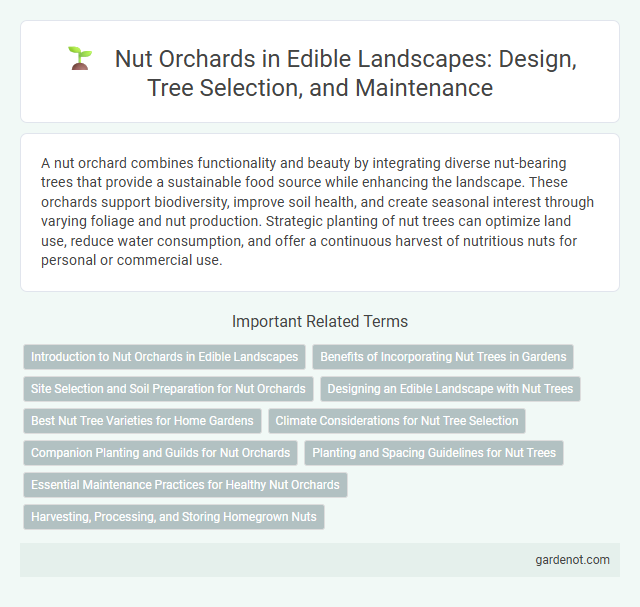A nut orchard combines functionality and beauty by integrating diverse nut-bearing trees that provide a sustainable food source while enhancing the landscape. These orchards support biodiversity, improve soil health, and create seasonal interest through varying foliage and nut production. Strategic planting of nut trees can optimize land use, reduce water consumption, and offer a continuous harvest of nutritious nuts for personal or commercial use.
Introduction to Nut Orchards in Edible Landscapes
Nut orchards play a vital role in edible landscapes by providing a sustainable source of nutrient-rich food and enhancing biodiversity. Commonly cultivated nut species include walnuts, pecans, almonds, and hazelnuts, each thriving in specific climate zones and soil conditions. Integrating nut trees into residential and commercial landscapes supports soil health, attracts pollinators, and contributes to long-term food security.
Benefits of Incorporating Nut Trees in Gardens
Incorporating nut trees in gardens enhances biodiversity by providing habitat for pollinators and beneficial insects. Nut orchards offer a sustainable source of nutrient-rich food, contributing to food security and reducing the need for store-bought snacks. These trees also improve soil health through nitrogen fixation and organic matter accumulation, supporting long-term garden productivity.
Site Selection and Soil Preparation for Nut Orchards
Selecting a well-drained site with full sun exposure is crucial for establishing a productive nut orchard, as most nut trees require deep, fertile soils with a pH between 6.0 and 7.0 for optimal growth. Soil preparation involves thorough testing to assess nutrient levels and organic matter content, followed by amendments such as compost and balanced fertilizers to improve soil structure and fertility. Proper drainage management and soil aeration techniques prevent root diseases and support strong tree development in nut orchards.
Designing an Edible Landscape with Nut Trees
Designing an edible landscape with nut trees involves selecting species such as walnut, pecan, hazelnut, and chestnut that thrive in local climate and soil conditions. Incorporating diverse nut trees enhances biodiversity, provides seasonal yields of protein-rich nuts, and supports pollinators essential for ecosystem health. Strategic spacing and companion planting optimize growth, minimize pests, and increase overall productivity of the nut orchard.
Best Nut Tree Varieties for Home Gardens
Chestnut, pecan, and walnut trees are among the best nut tree varieties for home gardens, offering a balance of productivity, size, and adaptability to diverse climates. Hazelnut and almond trees also thrive in smaller spaces, producing flavorful nuts while providing aesthetic appeal through their blossoms. Selecting disease-resistant cultivars enhances yield stability and reduces maintenance, making these nut trees ideal choices for sustainable edible landscapes.
Climate Considerations for Nut Tree Selection
Selecting nut tree species for an edible landscape requires careful evaluation of regional climate factors such as temperature extremes, chill hour requirements, and frost risk. Nut trees like black walnut and pecan thrive in temperate zones with well-defined seasons, while macadamia and cashew trees are better suited for subtropical or tropical climates with minimal frost. Assessing local soil drainage and precipitation patterns ensures optimal growth and nut production in a sustainable orchard setting.
Companion Planting and Guilds for Nut Orchards
Companion planting in nut orchards enhances soil fertility, pest control, and pollination by integrating diverse species like nitrogen-fixing plants, dynamic accumulators, and insectary flowers. Guilds for nut orchards typically include a nitrogen fixer such as clover or alder, nutrient accumulators like comfrey, and pest-repellent herbs including garlic or chives, creating a self-sustaining ecosystem. This strategic planting improves tree health, yields, and biodiversity while reducing the need for chemical inputs.
Planting and Spacing Guidelines for Nut Trees
Nut orchard planting requires careful spacing to ensure optimal growth and nut production, typically allowing 20 to 30 feet between large species like walnuts and pecans, while smaller trees such as hazelnuts can be spaced 10 to 15 feet apart. Proper spacing promotes adequate sunlight penetration and air circulation, reducing disease risk and enhancing nut quality. Deep planting in well-drained soil with ample organic matter supports healthy root development essential for high yields in diverse nut tree varieties.
Essential Maintenance Practices for Healthy Nut Orchards
Pruning nut trees annually enhances airflow and sunlight penetration, reducing disease risk and improving nut yield. Regular soil testing ensures balanced nutrient levels, supporting robust tree growth and maximizing production. Irrigation management tailored to the specific nut species prevents water stress and promotes healthy root development.
Harvesting, Processing, and Storing Homegrown Nuts
Harvest nuts when they fall naturally to the ground, indicating peak ripeness and optimal flavor. Process homegrown nuts by drying them in a well-ventilated, shaded area to prevent mold and preserve quality. Store fully dried nuts in airtight containers in a cool, dark place to extend shelf life and maintain freshness for months.
Nut orchard Infographic

 gardenot.com
gardenot.com